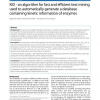252 search results - page 19 / 51 » Using OWL to model biological knowledge |
WEBI
2004
Springer
14 years 27 days ago
2004
Springer
The future success of Grid-enabled e-Science depends on the availability of semantic/knowledge-rich resources on the Grid, i.e., the so-called semantic Grid. This requires not onl...
BCB
2010
13 years 2 months ago
2010
A major bottleneck in high-throughput protein crystallography is producing protein-structure models from an electrondensity map. In previous work, we developed Acmi, a probabilist...
BMCBI
2010
13 years 7 months ago
2010
Background: The amount of available biological information is rapidly increasing and the focus of biological research has moved from single components to networks and even larger ...
SEMWEB
2007
Springer
14 years 1 months ago
2007
Springer
Partial knowledge about geospatial categories is critical for knowledge modelling in the geospatial domain but is beyond the scope of conventional ontologies. Degree of overlaps be...
RECOMB
2002
Springer
14 years 7 months ago
2002
Springer
Biological data, such as gene expression profiles or protein sequences, is often organized in a hierarchy of classes, where the instances assigned to "nearby" classes in...

